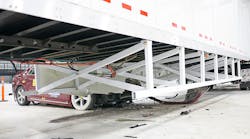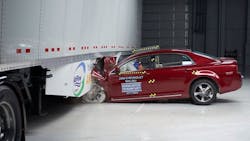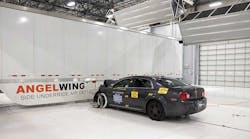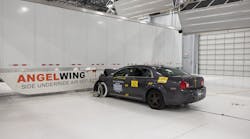An aftermarket tractor-trailer side guard passed a strict safety test Tuesday, but while safety researchers see the demonstration as another step toward reducing underride fatalities, a trailer industry representative cautions that extensive real-world testing is needed before effective side guard standards can be established.
Tuesday's test by the Insurance Institute for Highway Safety was the second for the AngelWing device produced by Airflow Deflector Inc, upping the speed of a midsize car from 35 mph to 40 mph—the speed at which IIHS conducts its frontal crash tests of passenger cars. A 40 mph crash involves 30 percent more energy than a 35 mph crash, IIHS notes.
The latest test was conducted during the Institute's second roundtable on truck underride crashes. Held at the IIHS Vehicle Research Center and cosponsored by the Truck Safety Coalition and AnnaLeah and Mary for Truck Safety, the event brought together safety advocates, researchers, government officials and industry leaders to discuss ways to make it safer for passenger vehicle occupants to share the road with large trucks.
Tractor-trailers are required under federal regulations to have underride guards on their rears, but not on their sides. Of the 1,542 deaths of passenger vehicle occupants in crashes with tractor-trailers in 2015, 301 involved the side of a tractor-trailer, compared with 292 that involved the rear.
"Our tests of the AngelWing show that measures to reduce the side underride problem are within reach," says David Zuby, IIHS executive vice president and chief research officer. "Broader use of devices like this one, combined with continued improvements to rear underride guards, would go a long way toward reducing deaths in large truck crashes."
The Tuesday test was "impressive," Truck Trailer Manufacturers Association President Jeff Sims told TBB. For his part of the program, Simms provided an industry progress update on the move to stronger rear underride devices, as well as some perspective on the evaluation of side guard equipment.
Along with pointing to highway safety data that shows about half of big truck fatalities do not involve "passenger compartment intrusion"—the sort of crash underride-protection devices are designed to mitigate—Sims noted the complexity of designing and installing devices for the wide range of trailer types and applications on the road today. Specifically, movable tandem axles make placing side guard devices problematic. Additionally, installing a device to protect the entire length of a trailer poses challenges.
And weight is “a main concern,” Sims noted, doing the math: Adding a roughly 800-lb. side guard to the trailer and displacing payload means additional trips will be needed to move the same amount of freight—and those extra truck trips also carry statistical baggage such as a greater number of accidents and fatalities, based on averages.
“There’s a lot more testing that has to be done for the manufacturability, different trailer configurations and installs,” Sims said. “And there’s no real-world testing yet. You’ve got to run these in all kinds of conditions. In the winter, you have to see how much ice and snow collect, and how that’s going to fall off. A big chuck of ice coming down the freeway at you is dangerous, as well.
“A successful test was done Tuesday, at 40 mph, in a direct, perpendicular collision. But what’s going happen at different angles, and will it redirect the car back into traffic?” Sims continued. “So there’s a lot more testing that has to be done, and data to be gathered.”
In Tuesday's test, a 2009 Chevrolet Malibu struck the center of a 53-foot-long dry van trailer at 40 mph. The outcome was similar to the 35 mph test with the AngelWing. The side guard bent but didn't allow the car to go underneath the trailer, and the car's airbags and safety belt properly restrained the dummy in the driver seat. Measures taken from the dummy showed there would be a low likelihood of injuries in a similar real-world crash.
In contrast, in a second 35 mph test conducted earlier this year with no side guard, the Malibu ended up lodged under the trailer with part of its roof torn off. In a real crash like that, there would likely be no survivors in the car.
The AngelWing is a result of a collaboration that came out of the first underride roundtable, held in May 2016 at the Vehicle Research Center. It was there that Airflow Deflector President Robert Martineau met Perry Ponder, president of Seven Hills Engineering, who had developed a design for a side underride guard. Together, they modified Ponder's invention and brought it into production.
While side guards that can prevent passenger vehicle underride are relatively new, lighter-weight guards to protect bicyclists and pedestrians are more common. At least three U.S. cities — Boston, New York and Seattle — require such guards on city-owned or contracted trucks as part of their Vision Zero initiatives.
Side underride guards were the focus of Tuesday's roundtable, which also touched on progress in addressing rear underride and the role of crash avoidance technologies in reducing underride fatalities.
"When people talk about Vision Zero, often what comes to mind is the potential for self-driving vehicles to eliminate crashes entirely," says David Harkey, who directs the University of North Carolina Highway Safety Research Center and delivered the roundtable's keynote. "While technology holds a lot of promise, it's going to take a long time to get there. There are things we can do now to save lives, and side underride guards are a perfect example."















